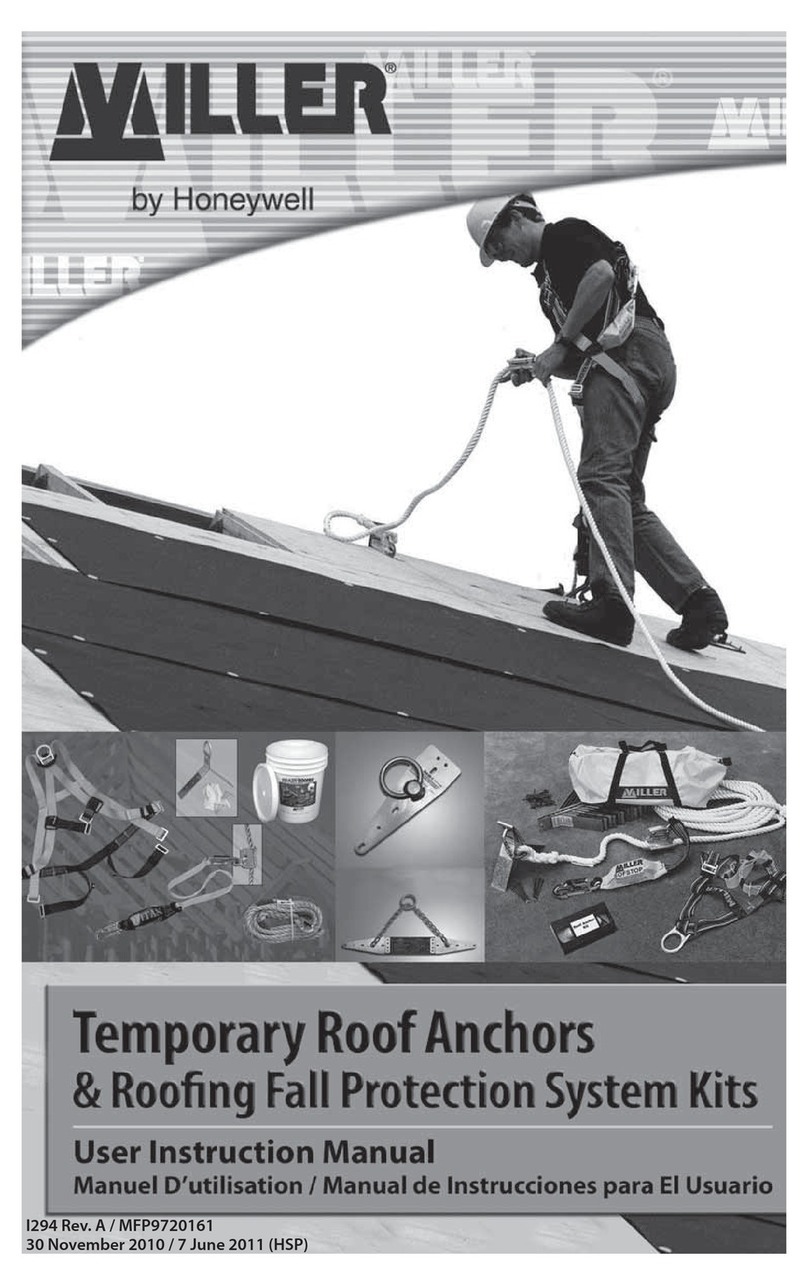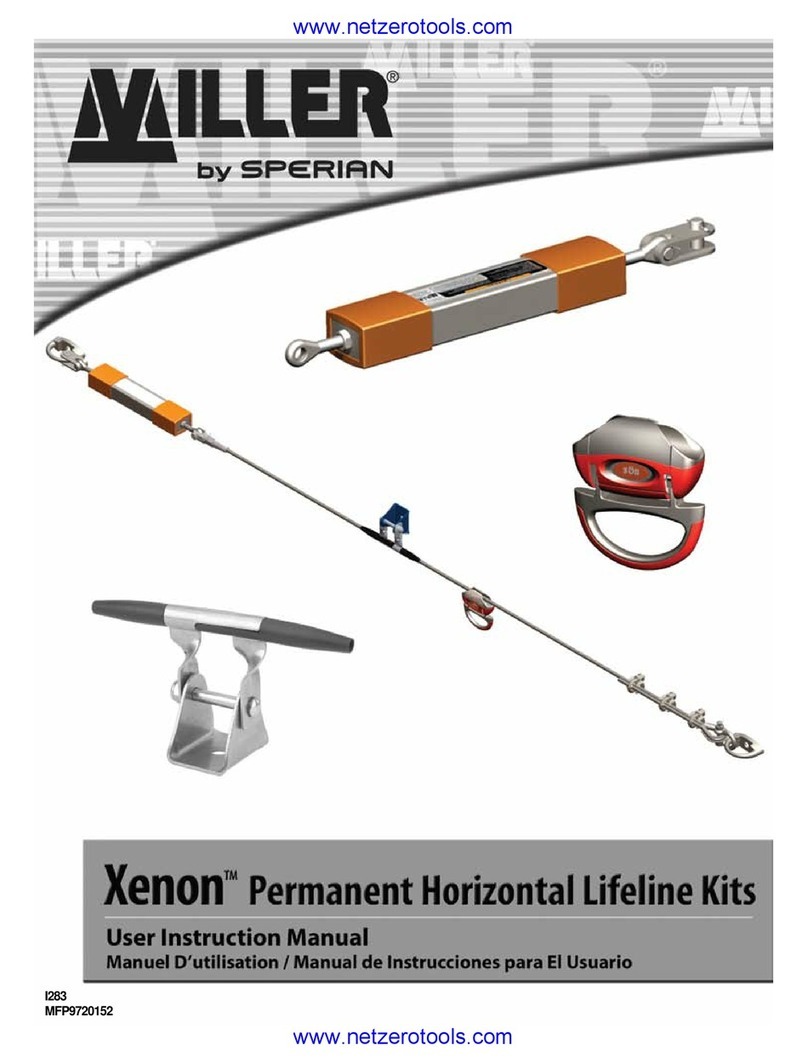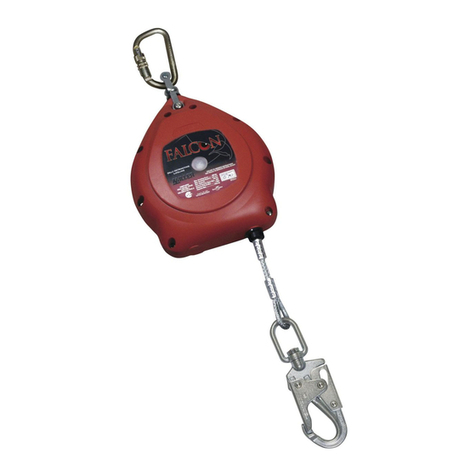
ONLY 1 PERSON PER ANCHORAGE IS PERMITTED AT ONE TIME.
CONNECTORS USED WITHIN THE SYSTEM MUST BE ABLE TO
LB515 REV. A
WARNING!
SUPPORT 5,000 LBS. THE USE OF NON-APPROVED
COMPONENTS MAY CAUSE SERIOUS INJURY OR DEATH.
ATTACH LIFELINE HERE HITCH PIN
HORIZONTAL BOOM INSTALLATION
1. READ, UNDERSTAND AND FOLLOW ALL INSTRUCTIONS
LB516 REV. A
BEFORE USING.
2. INSERT PUSH PIN THROUGH HORIZONTAL BOOM AND
INSTALL HITCH PIN THROUGH PUSH PIN AS SHOWN.
WARNING: BE SURE THE HITCH PIN HAS BEEN INSTALLED.
FAILURE TO DO SO MAY RESULT IN SERIOUS INJURY
OR DEATH.
PUSH PIN
HITCH PIN
WARNING: BE SURE THE HITCH PIN HAS BEEN INSTALLED.
LB517 REV. A
FAILURE TO DO SO MAY RESULT IN SERIOUS INJURY
OR DEATH.
VERTICAL BOOM INSTALLATION
AND INSTALL HITCH PIN THROUGH PUSH PIN AS SHOWN.
2. INSERT PUSH PIN THROUGH THE FRAME, VERTICAL BOOM
PUSH PIN
1. READ, UNDERSTAND AND FOLLOW ALL INSTRUCTIONS
BEFORE USING.
LB518 REV. A
MAY RESULT IN SERIOUS INJURY OR DEATH.
FAILURE TO FOLLOW MANUFACTURER'S INSTRUCTIONS
USING ONLY ONE LIFTING RING MAY CAUSE THE DEVICE TO
BECOME UNSTABLE OR UNBALANCED WHILE LIFTING.
WARNING!
DO NOT USE FOR FALL PROTECTION.
LIFTING RINGS
BOTH LIFTING RINGS MUST BE USED TO LIFT THE DEVICE.
BRAKE ENGAGEMENT:
ROTATE BRAKE HANDLE CLOCK-
WISE UNTIL HANDLE HAS
STOPPED.
ENGAGED BRAKES BEFORE EACH
USE. FAILURE TO DO SO MAY
RESULT IN SERIOUS INJURY
OR DEATH.
REVERSE ABOVE PROCEDURES
BRAKE DISENGAGEMENT:
LB520 REV. A
WARNING!
WARNING!
DO NOT EXCEED SAFE WORK ZONE
LB530 REV. A
MAY RESULT IN SERIOUS INJURY OR DEATH.
FAILURE TO FOLLOW MANUFACTURER'S INSTRUCTIONS
LEADING
EDGE
4. Inspect for malfunctioning components, broken or missing pins and fasteners. Replace if
5. at each rotates and moves freely and inspect for cuts, breaks, broken
ed.
ise to a complete stop.
8. m and all personal fall protection according to the manufacturer’s instructions.
Forma entire system and all
co
em and components
d
again for employee protection until inspected and determined by a competent person to be
ARNING: If inspection reveals a defect in condition, immediately remove the unit from service.
A. S
Servicing must only be carried out by a qualified person trained in the inspection and replacement of
nd all components of the system must be removed from service if
es. Contact Dalloz Fall Protection at 1-800-873-5242 if there are any
questions.
g, clean the unit to remove any dirt, grease or other materials that may have
ccumulated. Store in a clean dry area when not in use.
necessary.
Inspect wheels to ensure th
areas, excessive wear. Also, ensure that each wheel is securely fasten
6. Inspect brake jacks to ensure that each works properly and is capable of raising the unit when
crank handle has been rotated clock-w
7. Inspect all welds through out the unit for cracks, breaks, or corrosion.
Inspect syste
l Inspection: A competent person must perform an annual inspection of the
mponents.
Note: If the system has arrested a fall, an evaluation of the entire syst
subjected to impact loading shall be immediately removed from service and shall not be use
undamaged and suitable for reuse.
W
ERVICING
AINTENANCE:VI. M
this system. The company safety officer should maintain a record log of all servicing and inspection
dates for this unit. This unit a
subjected to fall arresting forc
B. CLEANING
Periodically clean the unit using a damp cloth and a non-abrasive mild soap or detergent. Towel dry.
C. STORAGE
Before storin
a
VII. WARNING LABELS:































